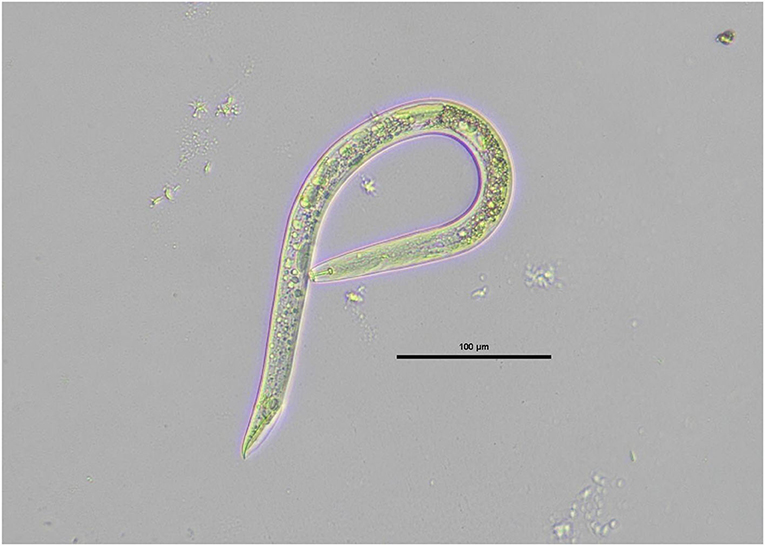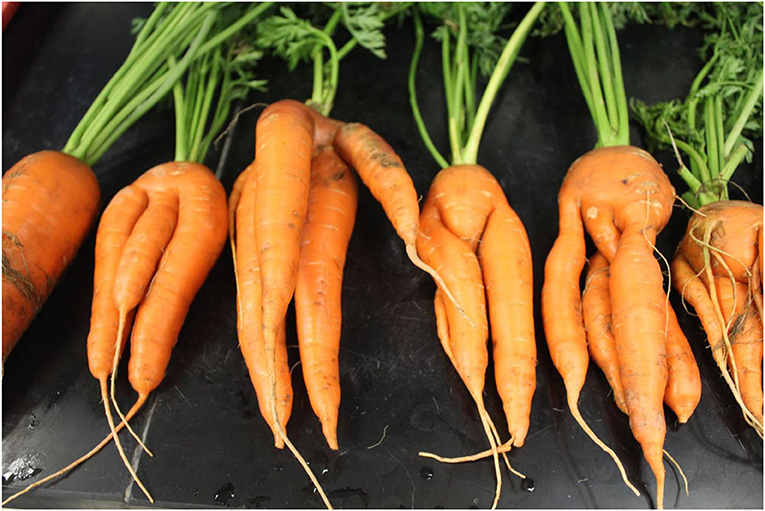Plant-eating nematodes and the key to fighting them
Plant roots interact with many bacteria, fungi and microscopic organisms within the soil that can impact how well the plants grow. Some of these microscopic organisms are nematodes, and they are an especially important part of the life in the soil.

Abstract
Plant roots interact with many bacteria, fungi, and microscopic organisms within the soil that can impact how well the plants grow. Some of these microscopic organisms are animals called nematodes, and they are an especially important part of the life in the soil. Nematodes can be good, bad, and neutral for plants. Some scientists called nematologists study nematodes and how to prevent the bad ones from damaging important crops, like carrots. Nematologists and other scientists partner up to help farmers manage these pests and grow healthy crops.
Little organisms can cause mighty problems
A handful of soil contains thousands of animals that are so small we need a microscope to see them. Tiny as these animals may be, some of them have a worldwide impact on the successful growth of food crops. Nematodes (Figure 1) are tiny roundworms that live in the soils of our gardens, crop fields, and landscapes. While some nematodes are helpful for plants, others are enemies of the plant world. These dangerous nematodes feed on plant roots, which ultimately damages the plant and severely impacts plant growth. While feeding, nematodes create wounds on the roots, which can leave the plant’s roots vulnerable to infection by other disease-causing organisms in the soil [1]. Nematodes that damage plant roots are often called parasites.

Plant-eating nematodes: A threat to root crops
Some garden plants have roots that we eat, like carrots, beets, parsnips, and potatoes. Nematodes can damage these important food crops along with many others. Nematodes possess a straw-like mouth part that injects a mixture of enzymes into the plant, which breaks down the plant cells into a plant-cell soup. After the cells are broken down, the nematodes eat up this soup [2]. When nematodes feed on carrot roots during the early stages of the plant’s life, this can cause serious damage or even the plant’s death. When some plant-parasitic nematodes feed on carrots and parsnips early in the growing season, they damage the roots so much that farmers cannot sell them. If certain nematodes of the genus Pratylenchus feed on very young carrots, the root damage causes the carrots to develop forked roots (Figure 2). When there are many of plant-parasitic nematodes in the soil, large crop losses can result.

Nematologists are scientists who study nematodes. Nematologists who research plant-parasitic nematodes can work with farmers to test the effectiveness of products that can kill dangerous nematodes, to find the best ways to combat these pests. Nematodes that eat root vegetables are particularly difficult to manage because sometimes farmers cannot see the symptoms of nematode infestation until the end of the season, when the roots are harvested.
How is a nematode infestation diagnosed?
Unlike insect pests, nematodes cannot be seen by the naked eye, so confirming a nematode infestation requires laboratory testing. If a farmer is concerned that he has plant-parasitic nematode damage, he can send a soil sample collected from his field to a nematology laboratory. In the laboratory, the soil is mixed with water and shaken through mesh sieves, in a process like sifting flour. The goal is to remove any large chunks of sand or other debris from the soil and capture only the nematodes. The mixture is transferred to tubes, which are put into a centrifuge—a large machine that spins extremely quickly to collect denser particles at the bottom of the tubes. The nematodes float in the water while heavier sand and mud particles stay in the bottom of the tube. Then, a sugar solution is added to the tube that causes the nematodes to float to the top of the tube. Scientists can collect the tiny animals and view them under a light microscope and identify which species of nematodes are in the farmer’s field. However, some species of nematodes look so much like other species that they need to be identified by analyzing their DNA.
How can farmers manage nematodes?
Nematologists and other scientists work together to tackle the issues that farmers face with nematodes. There are some chemicals, called nematicides, that are currently used to treat nematode infestations. These chemicals are toxic to nematodes but can also be dangerous for the person applying them, and they are also expensive. Nematologists are researching other effective ways for farmers to manage these pests. Some types of bacteria and fungi [3] present in soil have nematocidal qualities, meaning they can kill or inhibit nematodes, and some are so specialized that they only attack the bad nematodes [4]. Many current studies are trying to identify and grow these beneficial species, so they can be applied to farmers’ fields to lower the populations of bad nematodes in the soil. The most desirable nematicide would only be harmful to plant-parasitic nematodes, to ensure that soil resources and other helpful microscopic organisms in the soil are protected.
Fungi and bacteria: A potential key to fighting plant-parasitic nematodes
Plant-parasitic soil nematodes are dangerous pests that can damage plant roots and cause farmers to lose a lot of money due to unsellable crops. Thus, it is important to find effective ways to manage plant-parasitic nematodes. Ideally, these treatments should be safe for the environment and other soil-living species and should also be easily affordable for the farmer. This is a considerable challenge for nematologists, but the future is bright! The potential key solution is finding types of soil fungi or bacteria that can control plant-parasitic nematodes to develop new, effective, and environmentally friendly products for farmers to use. In addition, using nematode DNA to identify the different species of nematodes in soil has helped to advance the field of nematology. Sometimes molecular science like DNA analysis can be expensive but, by working together, scientists can make advances in molecular techniques that will make the process cheaper for future scientists and farmers. These techniques will pave the way for teams of nematologists and their partner scientists to help find the best ways to control these harmful pests.
Glossary
Nematode: A group of animals (Phylum: Nematoda) that have a worm-like shape that is long and cylindrical. They can be found on all seven continents (even Antarctica!), as well as in oceans and lakes.
Parasites: An organism that relies on another host organism to steal food and nutrients.
Enzymes: Biological molecules that induce chemical reactions within cells.
Nematologists: Scientists who study nematodes.
DNA: The instructions required to make up cells that is stored in every organism.
Nematicide: A substance or organism that is effective at killing nematodes.
Bacteria: A group of organisms that are prokaryotic, meaning that they lack a nucleus and only have one cell.
Fungi: A group of organisms that are eukaryotic (cells contain a nucleus) and feed on organic matter. This group includes mushrooms and yeasts that we eat, as well as mildews and molds.
Conflict of interest
The authors declare that the research was conducted in the absence of any commercial or financial relationships that could be construed as a potential conflict of interest.
References
[1] Shah, M. M., and Mahamood, M. 2017. Nematology: Concepts, Diagnosis and Control. BoD – Books on Demand.
[2] Zunke, U. 1990. Observations on the invasion and endoparasitic behavior of the root lesion nematode Pratylenchus penetrans. J. Nematol. 22:309–20.
[3] Poveda, J., Abril-Urias, P., and Escobar, C. 2020. Biological control of plant-parasitic nematodes by filamentous fungi inducers of resistance: Trichoderma, Mycorrhizal and Endophytic Fungi. Front. Microbiol. 11:992. doi: 10.3389/fmicb.2020.00992
[4] Topalović, O., Elhady, A., Hallmann, J., Richert-Pöggeler, K. R., and Heuer, H. 2019. Bacteria isolated from the cuticle of plant-parasitic nematodes attached to and antagonized the root-knot nematode Meloidogyne hapla. Sci. Rep. 9:11477. doi: 10.1038/s41598-019-47942-7
Citation
This article was originally published in Frontiers for Young Minds.
Darling E, Quintanilla-Tornel M and Chung H (2021) Plant-Eating Nematodes and the Key to Fighting Them. Front. Young Minds. 9:604175. doi: 10.3389/frym.2021.604175



 Print
Print Email
Email


